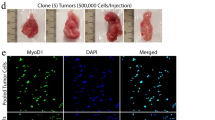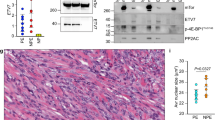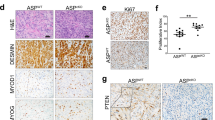Abstract
Gorlin (or nevoid basal cell carcinoma) syndrome is characterized by a variety of clinical problems including generalized overgrowth of the body, cysts, developmental abnormalities of the skeleton and a predisposition to benign and malignant tumors1,2. The syndrome results from germline mutations of the human homolog of the drosophila segment polarity gene patched (ptc)3,4. Here we report that mice heterozygous for ptc develop many of the features characteristic of Corlin syndrome and that they exhibit a high incidence of rhabdomyosarcomas (RMS), the most common soft-tissue sarcoma in children5. The downstream signalling partner of ptc, glil, was overexpressed in all RMSs analyzed, indicating that abnormal signalling of the ptc-glil pathway may be common for the various tumors6,7 associated with the syndrome. igf2, implicated in the formation of RMSs8, was also overexpressed, suggesting cross-talk between the ptc and igf2 pathways in tumorigenesis. Developemental defects in Corlin syndrome resemble those induced by ionizing radiation9. We show that ptc heterozygous mice exhibit increased incidence of radiation-induced teratogenesis. This suggests a role for ptc in the response to ionizing radiation and provides a model for both the systemic (developmental) and stochastic (cancer) abnormalities observed in Gorlin syndrome.
This is a preview of subscription content, access via your institution
Access options
Subscribe to this journal
Receive 12 print issues and online access
$209.00 per year
only $17.42 per issue
Buy this article
- Purchase on Springer Link
- Instant access to full article PDF
Prices may be subject to local taxes which are calculated during checkout
Similar content being viewed by others
References
Bal, A.E. Variable expressivity of patched mutations in flies and humans. Am. J. Hum. Genet. 60, 10–12 (1997).
Gorlin, R.J. Nevoid basal-cell carcinoma syndrome. Medicine (Baltimore) 66, 98–113 (1987).
Hahn, H. et al. Mutations of the human homolog of Drosophila patched in the nevoid basal cell carcinoma syndrome. Cell 85, 841–851 (1996).
Johnson, R.L. et al. Human homolog of patched, a candidate gene for the basal cell nevus syndrome. Science 272, 1668–1671 (1996).
Pappo, A.S., Shapiro, D.N. & Crist, W.M. Rhabdomyosarcoma. Biology and treatment. Pediatr. Clin. North. Am. 44, 953–972 (1997).
Goodrich, L.V., Milenkovic, L., Higgins, K.M. & Scott, M.P. Altered neural cell fates and medulloblastoma in mouse patched mutants. Science 277, 1109–1113 (1997).
Dahmane, N. et al. Activation of the transcription factor Gli1 and the Sonic hedgehog signalling pathway in skin tumours. Nature 389, 876–881 (1997).
Zhan, S. et al. Concordant loss of imprinting of the human insulin-like growth factor II gene promoters in cancer. J. Biol. Chem. 270, 27983–27986 (1995).
Hall, E.J. Effects of radiation on the embryo and fetus. In: Radiobiology for the radiologist (J.B. Lippincott Company,–Philadelphia, 1994).
Cossu, G., Tajbakhsh, S. & Buckingham, M. How is myogenesis initiated in the embryo? Trends Genet. 12, 218–23 (1996).
Hynes, M. et al. Control of cell pattern in the neural tube by the zinc finger transcription factor and oncogene Gli-1. Neuron 19, 15–26 (1997).
Albrecht, S. et al. Variable imprinting of H19 and IGF2 in fetal cerebellum and medulloblastoma. J. Neuropathol. Exp. Neurol. 55, 1270–1276 (1996).
Sun, F.L., Dean, W.L., Kelsey, G., Allen, N.D. & Reik, W. Transactivation of Igf2 in a mouse model of Beckwith-Wiedemann syndrome. Nature 389, 809–815 (1997).
Shapiro, D.N., Sublett, J.E., Li, B., Downing, J.R. & Naeve, C.W. Fusion of PAX3 to a member of the forkhead family of transcription factors in human alveolar rhabdomyosarcoma. Cancer Res. 53, 5108–5112 (1993).
Rugh, R. The mouse: its reproduction and development (Oxford University Press, New-York, 1990).
Goodrich, L.V., Johnson, R.L., Milenkovic, L., McMahon, J.A. & Scott, M.P. Conservation of the hedgehog/patched signaling pathway from flies to mice: induction of a mouse patched gene by Hedgehog. Genes Dev. 10, 301–312 (1996).
Levanat, S. et al. A two-hit model for developmental defects in Gorlin syndrome. Nature Genet. 12, 85–87 (1996).
Arlett, C.F. & Priestley, A. Deficient recovery from potentially lethal damage in some gamma-irradiated human fibroblast cell strains. Br. J. Cancer Suppl. 6, 227–232 (1984).
Featherstone, T., Taylor, A.M. & Harnden, D.G. Studies on the radiosensitivity of cells from patients with basal cell naevus syndrome. Am. J. Hum. Genet. 35, 58–66 (1983).
Waldman, T. et al. Cell-cycle arrest versus cell death in cancer therapy. Nature Med. 3, 1034–1046 (1997).
Author information
Authors and Affiliations
Rights and permissions
About this article
Cite this article
Hahn, H., Wojnowski, L., Zimmer, A. et al. Rhabdomyosarcomas and radiation hypersensitivity in a mouse model of Gorlin syndrome. Nat Med 4, 619–622 (1998). https://doi.org/10.1038/nm0598-619
Received:
Accepted:
Issue Date:
DOI: https://doi.org/10.1038/nm0598-619
This article is cited by
-
Hedgehog signaling in tissue homeostasis, cancers, and targeted therapies
Signal Transduction and Targeted Therapy (2023)
-
Haploinsufficiency of the lysosomal sialidase NEU1 results in a model of pleomorphic rhabdomyosarcoma in mice
Communications Biology (2022)
-
Context-dependent modulation of aggressiveness of pediatric tumors by individual oncogenic RAS isoforms
Oncogene (2021)
-
Up-regulation of GLI1 in vincristine-resistant rhabdomyosarcoma and Ewing sarcoma
BMC Cancer (2020)
-
Rhabdomyosarcoma
Nature Reviews Disease Primers (2019)



